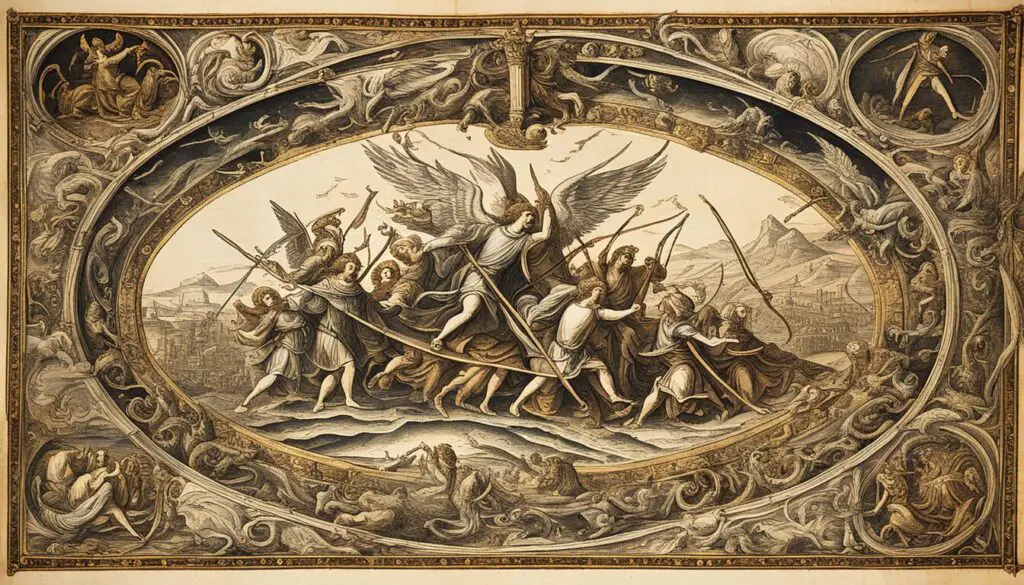Welcome to our exploration of the mysterious biblical book of Revelations. In this section, we will embark on a journey through time to uncover the origins and historical context of this enigmatic text. Dive deep into the depths of history as we seek to answer the question: when was Revelations written?
Revelations, also known as the Book of Revelation or the Apocalypse of John, is the final book of the New Testament, widely regarded as a prophetic work filled with vivid imagery and apocalyptic themes. Its authorship and date of composition have been subjects of much debate among scholars and theologians, adding to its intrigue and significance.
As we delve into the origins of Revelations, we will examine the historical backdrop against which it was written. By understanding the political, religious, and social context of the time, we can better grasp the message and intent behind this profound biblical work.
Are you ready to uncover the secrets of Revelations? Let’s journey together into the past and unravel the mysteries surrounding its creation.
Key Takeaways:
- Revelations is a biblical book filled with prophetic imagery and apocalyptic themes.
- The authorship and date of composition of Revelations have been subjects of much debate.
- Understanding the historical context is crucial in interpreting the message of Revelations.
- Uncovering the secrets of Revelations requires delving deep into the enigmatic past.
- Join us on this journey as we seek to unravel the mysteries of Revelations.
Unraveling the Authorship of Revelations
In the biblical book of Revelations, an unprecedented and mysterious vision of the future is unfolded. As we embark on a journey to understand the true authorship of this profound text, we are met with a myriad of theories and perspectives. Who, indeed, had the pen that brought forth these awe-inspiring prophecies?
One of the widely debated theories is that the author of Revelations was none other than the apostle John, the beloved disciple of Jesus. This perspective draws from early Christian traditions and attributes the profound insights of the book to the firsthand experiences and divine revelations bestowed upon John.
However, an alternate viewpoint emerges wherein some scholars argue that the authorship of Revelations may have been attributed to another John, such as John the Presbyter or John of Patmos. These theories propose that the authorship could be the result of a collective effort or influenced by various religious circles during that period.
It is also worth considering the possibility of an unknown author who used the name “John” as a literary device to lend credibility to the prophetic work. This literary convention prevalent at the time could have served to convey a sense of authority and authenticity to the readers.
Different Perspectives on the Authorship
As we delve deeper into the authorship of Revelations, diverse interpretations continue to arise. Some scholars lean towards a single individual as the sole author, while others speculate on collaborative efforts or the influence of a community. This diversity of perspectives adds to the intrigue and enigma surrounding the origin of this biblical masterpiece.
As we navigate through the complex web of authorship theories, one thing remains certain – the book of Revelations continues to captivate hearts and minds, regardless of the identity of its author. The profound message conveyed within its pages transcends time and speaks to the eternal human search for meaning and purpose.
Setting the Stage: Historical Context of Revelations
To truly understand the book of Revelations, one must delve into its historical context. The political, religious, and social climate in which this profound biblical text was written provides valuable insights into its meaning and significance.
In the first century AD, the Roman Empire exerted dominance over a vast territory, including the region of modern-day Israel. The Jewish population, who held strong religious beliefs and traditions, found themselves under Roman rule, which often led to tensions and conflicts. This backdrop of political unrest and cultural clashes influenced the mindset of the author of Revelations.
During this period, various religious movements emerged, each with its own set of beliefs and practices. Judaism, with its long history and rich traditions, played a significant role in shaping the context in which Revelations was written. The author would have been aware of the Jewish apocalyptic literature, which often contained visions and prophecies about the end times.
Furthermore, the rise of Christianity, which stemmed from Jewish roots but developed its own distinct identity, introduced a new perspective on eschatology, or the study of the end of times. The spreading influence of Christianity undoubtedly had an impact on the thoughts and beliefs of the author and the intended audience of Revelations.
The culture of the time was also marked by religious syncretism, where different religious ideas and practices blended together. This environment of religious diversity and interaction may have contributed to the eclectic imagery and symbolism found within the book of Revelations.
In summary, the historical context in which Revelations was written was one of political turmoil, religious diversity, and apocalyptic anticipation. By exploring this backdrop, we can gain a deeper understanding of the symbols, themes, and messages encapsulated within this enigmatic biblical text.
A Timeline of the Book of Revelations
Embark on a journey through time as we unveil a fascinating timeline of key events and developments within the book of Revelations. This chronological exploration offers a unique perspective into the sequence of events that shape the narrative, allowing us to uncover the profound messages hidden within.
Let’s start at the beginning. The book of Revelations opens with the visionary experience of the Apostle John on the island of Patmos. It is believed that John wrote down these revelations around AD 95-96, during the reign of the Roman emperor Domitian.
As we dive deeper into the timeline, significant moments start to emerge. One pivotal event is the opening of the seven seals, each revealing a different aspect of the end times. These seals are followed by the sounding of the seven trumpets, which herald catastrophic events symbolizing God’s judgment.
Continuing on our journey, we encounter the vision of the woman and the dragon, representing the cosmic battle between good and evil. This allegorical depiction serves as a reminder of the spiritual warfare that rages throughout human history.
Another important moment is the rise of the beast with ten horns, symbolizing a powerful empire. This beast is challenged by the Lamb of God, who ultimately triumphs over evil. This victory signals the beginning of a new era and the establishment of God’s kingdom on Earth.
And finally, the book of Revelations concludes with the vision of the New Jerusalem descending from heaven, a symbol of the eternal dwelling place of God’s people. This vision offers hope and reassurance to believers, reminding them of the ultimate fulfillment of God’s promises.
This timeline of the book of Revelations provides a framework for understanding the prophetic vision and symbolic language utilized throughout the text. By examining the sequence of events and their significance, we gain deeper insights into the transformative power of this biblical masterpiece.
Discerning the Date of Composition of Revelations
When it comes to uncovering the date of composition for the book of Revelations, scholars utilize various methods to piece together the puzzle of its origins. By examining historical clues and textual evidence, we begin to paint a clearer picture of the timeline in which this profound biblical text was written.
One approach that scholars take is analyzing the historical context surrounding the book of Revelations. By studying the political, religious, and social climate of the time, we can gain insights into the events that may have influenced its composition.
Another method used is exploring references and allusions within the text itself. By identifying connections to specific historical events or figures, we can narrow down the possible timeframe of its creation.
Additionally, linguistic and stylistic analysis play a crucial role in determining the date of composition. By examining the language, vocabulary, and writing style employed in Revelations, scholars can compare it to other texts from the same period to identify commonalities or distinctive features.
Furthermore, some scholars examine the manuscript and textual variations of Revelations to gain insights into its development and potential timeline of composition. These variations, found in ancient manuscripts and translations, offer valuable clues about the evolution of the text over time.

The quest to discern the exact date of composition for the book of Revelations is an ongoing endeavor, as the evidence is subject to interpretation and debate. Yet, through the meticulous examination of historical context, textual analysis, and linguistic clues, scholars continue to make progress in narrowing down the possible timeline.
Revelations and the Early Christian Movement
Understanding the date of composition for Revelations is not only important for historical accuracy but also for its significance within the early Christian movement. By placing this profound text in its proper historical context, we can gain deeper insights into its message and its impact on the communities that received it.
The Revelation of John: Decoding the Messenger
In the intriguing biblical book of Revelations, the figure of John emerges as the supposed primary author and recipient of the divine revelations. This section aims to shed light on the enigmatic messenger known as John, exploring the prevailing theories surrounding his identity and the context in which his revelations were received.
According to scholarly discourse, the identity of John remains a subject of debate. While some believe that he was the apostle John, the son of Zebedee and a close disciple of Jesus, others propose that he may have been a different John, such as John of Patmos, John the Elder, or even a symbolical representation of a collective group.
Despite the uncertainties surrounding his identity, John’s visions in Revelations provide profound insight into eschatological themes and apocalyptic imagery. The book offers a glimpse into the divine revelations received by John, presenting a vivid portrayal of the end times and the ultimate victory of good over evil.
To truly comprehend the revelations of John, it is essential to consider the historical, cultural, and religious context in which these messages were conveyed. Scholars analyze the language, style, and symbolism of the book, interpreting its intended meaning within the framework of the author’s socio-historical milieu.
Contextualizing John’s Revelations
Revelations is believed to have been written during a time of intense persecution of early Christians under the Roman Empire. The book’s prophetic visions carry both a call to endurance and a message of hope to persecuted believers.
One prevailing theory suggests that the date of composition for Revelations falls around the latter part of the first century, specifically during the reign of Emperor Domitian, who was known for his persecution of Christians. However, other scholars propose alternative dates, such as the mid-60s during the reign of Emperor Nero.
By examining the historical and cultural context, we gain a deeper appreciation of the challenges faced by early Christians and the significance of John’s visions in providing them solace and encouragement.
In summary, this section has provided an overview of John, the central figure in the book of Revelations. It has explored the theories surrounding his identity and the contextual backdrop against which his revelations were received. The next section will delve into the early interpretations and reception of the book, unveiling the impact it had on the burgeoning Christian communities of the time.
Early Interpretations and Reception of Revelations
When the book of Revelations was first introduced to early Christian communities, it sparked a wave of intrigue and curiosity. This enigmatic text, packed with vivid imagery and prophetic visions, left believers and scholars alike grappling with its interpretations.
The book of Revelations offers a glimpse into the spiritual realm, culminating in the ultimate battle between good and evil. Its mysterious nature allowed for a wide range of interpretations, resulting in diverse perspectives among early Christians. Some saw it as a literal account of future events, while others viewed it as symbolic representations of contemporary struggles and triumphs.
One common interpretation of the book of Revelations was that it depicted the cosmic conflict between the forces of God and Satan, symbolizing the ongoing spiritual battle faced by believers. The apocalyptic imagery and eschatological themes captured the imagination and provided hope for those navigating a tumultuous world.
Another interpretation emphasized the book’s relevance to the historical context of the early church. It was seen as a critique of the Roman Empire and its oppressive rule, offering encouragement to persecuted Christians. The celestial visions and divine judgments outlined in Revelations provided reassurance that justice would prevail in the face of adversity.
The interpretations of the book of Revelations had a profound impact on subsequent generations. They influenced theological discussions, shaped the understanding of eschatology, and even played a role in shaping social and political movements throughout history.

Controversies and Debates Surrounding Revelations
Dive into the controversies and debates that have arisen in relation to the book of Revelations. This enigmatic biblical text has sparked intense discussions and conflicting viewpoints among scholars and theologians throughout history.
One of the main controversies surrounds the interpretation of the symbolic language and imagery used in Revelations. Some argue that the events described are literal and depict future cataclysmic events, while others view them as metaphorical representations of the ongoing struggle between good and evil.
The question of whether the events prophesied in Revelations have already occurred or are yet to come is another point of debate. Some believe that the book primarily pertains to the first-century Roman Empire and its persecution of early Christians, while others contend that it contains prophecies for the future end times.
Furthermore, the relevance of Revelations in modern times is a topic of intense scrutiny. Some argue that its apocalyptic themes and warnings about the consequences of human actions hold valuable lessons for contemporary society. Others believe that interpreting Revelations’ symbolism in today’s context is speculative and may lead to misinterpretation.
Regardless of the ongoing controversies and debates, the book of Revelations continues to captivate and inspire readers with its vivid imagery and portrayal of cosmic battles between good and evil. Its profound messages and theological depth make it a subject of ongoing inquiry and interpretation.
Unveiling the Mysteries
While the debates persist, the allure of Revelations lies in its ability to provoke deep reflection and contemplation. By exploring the various perspectives and engaging in meaningful dialogue, we can strive for a better understanding of this sacred text and its implications for our lives.
Join us in the next section as we take a closer look at Revelations’ influence on art and culture, and how its eschatological themes have left an indelible mark on human expression throughout the centuries.
The Influence of Revelations on Art and Culture
Discover the profound impact that the book of Revelations has had on art, literature, and popular culture throughout history. Its themes, symbolism, and apocalyptic imagery continue to inspire creativity and captivate audiences.
Revelations’ visionary narrative and vivid descriptions have served as a source of inspiration for countless artists, writers, and filmmakers. The book’s rich symbolism, such as the Four Horsemen of the Apocalypse or the Great Whore of Babylon, has found its way into various art forms, from paintings and sculptures to poetry and music.
The enigmatic nature of Revelations has stimulated the imagination of artists, allowing them to explore profound existential questions and convey a sense of awe, wonder, and mystery. The book’s themes of divine judgment, human salvation, and the struggle between good and evil have provided fertile ground for artistic expression.
One of the most notable representations of Revelations in art is the iconic painting “The Last Judgment” by Michelangelo in the Sistine Chapel. This masterpiece depicts the climactic moment of the final judgment, with angels and demons swirling around as souls ascend to heaven or descend into hell. It showcases the timeless influence of Revelations on art and its ability to evoke deep emotions and contemplation.
In literature, Revelations has served as a source of inspiration for numerous authors, weaving its apocalyptic themes into works of fiction. The allegorical nature of the book has allowed writers to explore complex narratives and examine the human condition in the face of impending doom or profound transformation.
The book’s cultural impact extends beyond the realm of high art and literature. Revelations has left its mark on popular culture, finding its way into films, television shows, and even video games. Its themes of cataclysmic events, cosmic battles, and ultimate redemption have captivated audiences and provided a layered backdrop for storytelling and entertainment.
Through its influence on art and culture, Revelations continues to provoke thought, spark creativity, and resonate with individuals across different time periods and societies. Its profound themes and enigmatic symbolism offer an enduring source of inspiration and contemplation.

Eschatological Themes in Revelations
Within the book of Revelations, readers are immersed in a world of powerful eschatological themes that continue to captivate the imagination. These apocalyptic visions and prophecies have both fascinated and unsettled generations, offering a glimpse into the ultimate divine plan and the destiny of humanity.
One of the recurring motifs in Revelations is the depiction of a cosmic battle between the forces of good and evil, with the final judgment and the establishment of a new heavenly kingdom as the ultimate outcome. Through vivid imagery and symbolic language, the author paints a compelling picture of the end times, inviting readers to reflect on the ultimate significance and meaning of their own lives.
Apocalyptic themes such as the destruction of the world, celestial signs, and the coming of the Antichrist are intricately woven into the fabric of Revelations. The book presents a vision of a world in turmoil, where chaos and darkness prevail before the ultimate triumph of divine justice and redemption.
The Symbolism of Revelations
Revelations employs a rich tapestry of symbolism and allegory to convey its eschatological message. The use of numbers, colors, and animal imagery serves to deepen the layers of meaning within the text, allowing readers to engage with its profound symbolism on multiple levels.
Apocalyptic literature, including the book of Revelations, has long been a source of inspiration for artists, writers, and thinkers throughout history. Its themes of cosmic struggle, divine intervention, and the ultimate resolution of human history continue to resonate in contemporary culture.
Modern Interpretations and Relevance of Revelations
In today’s ever-changing world, the ancient biblical book of Revelations continues to captivate and intrigue readers across the globe. Its vivid imagery, prophetic messages, and apocalyptic themes have sparked a multitude of modern interpretations that explore its relevance for contemporary society.
One modern interpretation of Revelations revolves around its symbolic representation of the eternal struggle between good and evil. Some see this book as a reminder of the constant battles and moral dilemmas we face in our daily lives. The imagery of cosmic conflict serves as a powerful metaphor for the inner struggles we endure as individuals and as a society.
Another perspective on Revelations emphasizes its relevance in the context of environmental issues and climate change. As humanity grapples with the consequences of our actions on the planet, some find resonance with the book’s warnings about the destruction of the Earth and the urgent need for stewardship and redemption.
Additionally, Revelations is often seen as a source of inspiration for those seeking spiritual guidance and reassurance in uncertain times. Its message of hope and triumph in the face of adversity provides solace and encouragement to readers navigating personal challenges or societal upheaval.
Furthermore, the book of Revelations continues to be a subject of intense scholarly study, unraveled through the lens of historical, cultural, and theological perspectives. This ongoing exploration sheds light on the book’s multifaceted nature and its enduring relevance for diverse communities.
Modern interpretations of Revelations serve as a testament to the enduring power and significance of this ancient text. By engaging with its themes and symbols, contemporary readers find meaning, guidance, and inspiration in the midst of the complexities of our modern world.
Conclusion
In conclusion, the question of when the book of Revelations was written continues to ignite passionate debates and inspire profound interpretations. While a definitive answer remains elusive, exploring its historical context, authorship, and underlying themes opens up a world of understanding and appreciation for this enigmatic biblical text.
By immersing ourselves in the political, religious, and social climate of the time, we gain invaluable insights into the motivations and inspirations behind Revelations. Whether it was written during the tumultuous times of the Roman Empire or later during the time of Domitian, the enduring impact of this text cannot be denied.
As we unravel the authorship theories, from attributing it to the apostle John to considering other possibilities, we come to appreciate the rich tapestry of voices and perspectives that have shaped the book. It is not simply the work of one individual, but a testament to the collective imagination and spiritual yearnings of a community.
In exploring its themes of apocalypse, eschatology, and visions of the future, we come face to face with the timeless questions of human existence, morality, and our place in the grand tapestry of creation. The book of Revelations continues to inspire awe, curiosity, and reflection in both ancient and modern societies alike, challenging us to contemplate the mysteries of life and the divine.





